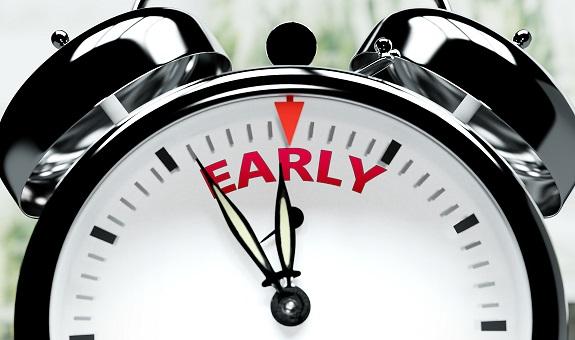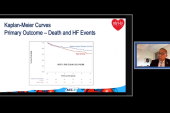Heart Failure Patients With AF Benefit From Early Rhythm Control
The prespecified analysis from EAST-AFNET 4 of mostly HFpEF patients should be “reassuring,” one investigator says.

Andreas Rillig, MD (Charité University Hospital of Berlin, Germany), presented the trial’s prespecified subanalysis of heart failure patients as a late breaker at the Heart Rhythm Society (HRS) 2021 Scientific Sessions today. The paper was simultaneously published in Circulation.
As Rillig and colleagues note in their paper, nearly one-third of patients with AF also have heart failure, and this dual diagnosis amplifies their risk of adverse cardiovascular events. The primary EAST-AFNET 4 results showed significant benefits with early initiation of rhythm-control therapy (primarily antiarrhythmic drugs) in nearly 2,800 patients with other cardiac conditions and recently diagnosed AF as compared with usual care, but whether these same benefits extend to patients with heart failure was unclear, particularly those with heart failure and preserved ejection fraction (HFpEF).
Speaking with TCTMD, senior study author Paulus Kirchhof, MD (University Heart and Vascular Center, Hamburg, Germany, and the University of Birmingham, England), explained that certain rhythm-control drugs in patients with heart failure have “a reputation of being dangerous,” a concern left over from the CAST and AFFIRM trials.
“That's still in the minds of people,” he said, “But in EAST, there was no safety signal at all. Early rhythm control in my view really conveys clinical benefit and should be part of the standard treatment of patients with atrial fibrillation and heart failure.”
EAST-AFNET 4 Heart Failure Subset
In all, 798 patients in the trial with heart failure were included in the analysis, including 396 randomized to early rhythm therapy (ERT) and 402 to usual care, typically rate control. The majority (n = 442) had HFpEF—“similar to the CABANA trial,” Rillig said.
Over a median of 5.1 years, the primary endpoint of cardiovascular death, stroke, or hospitalization for worsening heart failure or acute coronary syndromes was significantly reduced in patients randomized to ERT as opposed to usual care (HR 0.74; 95% CI, 0.56-0.97), with curves beginning to separate around the 6-month mark. The primary safety outcome—death, stroke, or serious adverse events related to rhythm-control therapy—was no different between groups, occurring in 17.9% of the ERT group and 21.6% in the usual care group.
“Early therapy as delivered in this trial is safe, and it reduces cardiovascular outcomes by 25% in patients with heart failure,” Kirchhof summarized for TCTMD.
Left ventricular function improved in both trial arms, a finding Kirchhof called “puzzling.”
“I think the reason behind that is that usual care in our design allowed for rhythm-control therapy in symptomatic patients,” he said. But patients with better LV function at the study outset were also less likely to have a cardiovascular event than were patients with reduced LVEF. This is “in line” with prior studies suggesting that LVEF is an important prognostic indicator in the setting of HF and AF, the authors noted.
I think it actually gives quite a few treatment options to meet the desires and needs of all patients with atrial fibrillation and heart failure. Paulus Kirchhof
Rillig, speaking during a morning press conference, said that the clinical benefits of early rhythm control seen “across the spectrum of heart failure subtypes” is “important.”
“Our study supports a treatment strategy of early rhythm control with antiarrhythmic drugs or AF ablation within the year of diagnosing atrial fibrillation in patients with signs or symptoms of heart failure to reduce cardiovascular outcomes,” he concluded.
Practice Implications
Commenting on the study for TCTMD, Jason G. Andrade, MD (Vancouver General Hospital, Canada), stressed that heart failure patients represent a group in whom adverse event rates are typically higher than that seen in the general AF population. “The key message from the paper is the that the overall results of the EAST trial were replicated in the HF subpopulation,” he said. “We can expect mortality and hospitalization outcomes to be reduced with early rhythm control in these patients presenting with heart failure.”
Of note, said Andrade, investigators undertook a secondary analysis applying the endpoint used in the recent CASTLE-AF trial (death from any cause or hospitalization for worsening heart failure), which showed ablation to be superior to antiarrhythmic drugs in patients with heart failure. Even with this alternate endpoint, early rhythm-control therapy in EAST-AFNET 4 demonstrated a benefit, Andrade noted, despite the fact that CASTLE-AF was focused on HFpEF patients and randomized patients between drugs or ablation. A 2019 AF guideline update upgraded ablation to a new class IIb recommendation: “reasonable” in selected patients with symptomatic AF and heart failure with reduced LVEF.
Indeed, press conference moderator Jodie Hurwitz, MD (Medical City Hospital, Dallas, TX), told TCTMD that EAST-AFNET 4 “already has started to move the needle.”
“I think that several of us are looking in particular to try and see where this will lead in terms of changing guidelines,” she said. “The initial study itself was incredibly important, and many of us in some ways had already considered early rhythm control in this group of patients. In terms of the heart failure population, I think this is very interesting data.”
Much of the recent research has been focused on AF ablation, Rillig reiterated, so seeing the same benefits in patients treated medically is important.
What that allows for, said Kirchhof, are options.
“There will be patients who don't want to take more pills, and the beauty of the early-rhythm-control strategy in EAST is that it was achieved using a variety of treatment patterns,” Kirchhof told TCTMD. “So if someone says, ‘I don't want to take more pills,’ you can offer them ablation straight away and that is a completely viable option. But if someone says, ‘I don't want an intervention,’ you could offer them antiarrhythmic drugs and then reconsider AF ablation if they have recurrent atrial fibrillation. I think it actually gives quite a few treatment options to meet the desires and needs of all patients with atrial fibrillation and heart failure.”
Shelley Wood was the Editor-in-Chief of TCTMD and the Editorial Director at the Cardiovascular Research Foundation (CRF) from October 2015…
Read Full BioSources
Rillig A, Magnussen C, Ozga A-K, et al. Early rhythm control therapy in patients with atrial fibrillation and heart failure. Circulation. 2021:Epub ahead of print.
Disclosures
- Rillig reports grants and consulting fees from Philips, Medtronik, Biosense Webster, and Cardiofocus; consulting fees from Ablamap; and payment or honoraria for lectures, presentations, speakers bureaus, manuscript writing or educational events from Philips, Medtronik, Ablamap, Cardiofocus, Biosense, Bayer and Novartis; payment for expert testimony from Philips, and support for attending meetings and/or travel from Philips, Medtronik, Ablamap, Cardiofocus, and Biosense Webster.
- Kirchhof reports research support for basic, translational, and clinical research projects from the European Union, British Heart Foundation, Leducq Foundation, Medical Research Council UK), and German Centre for Cardiovascular Research, and from several drug and device companies active in atrial fibrillation, receiving honoraria from several such companies in the past, but not in the last 3 years. He is also listed as inventor on two patents held by University of Birmingham.




Comments